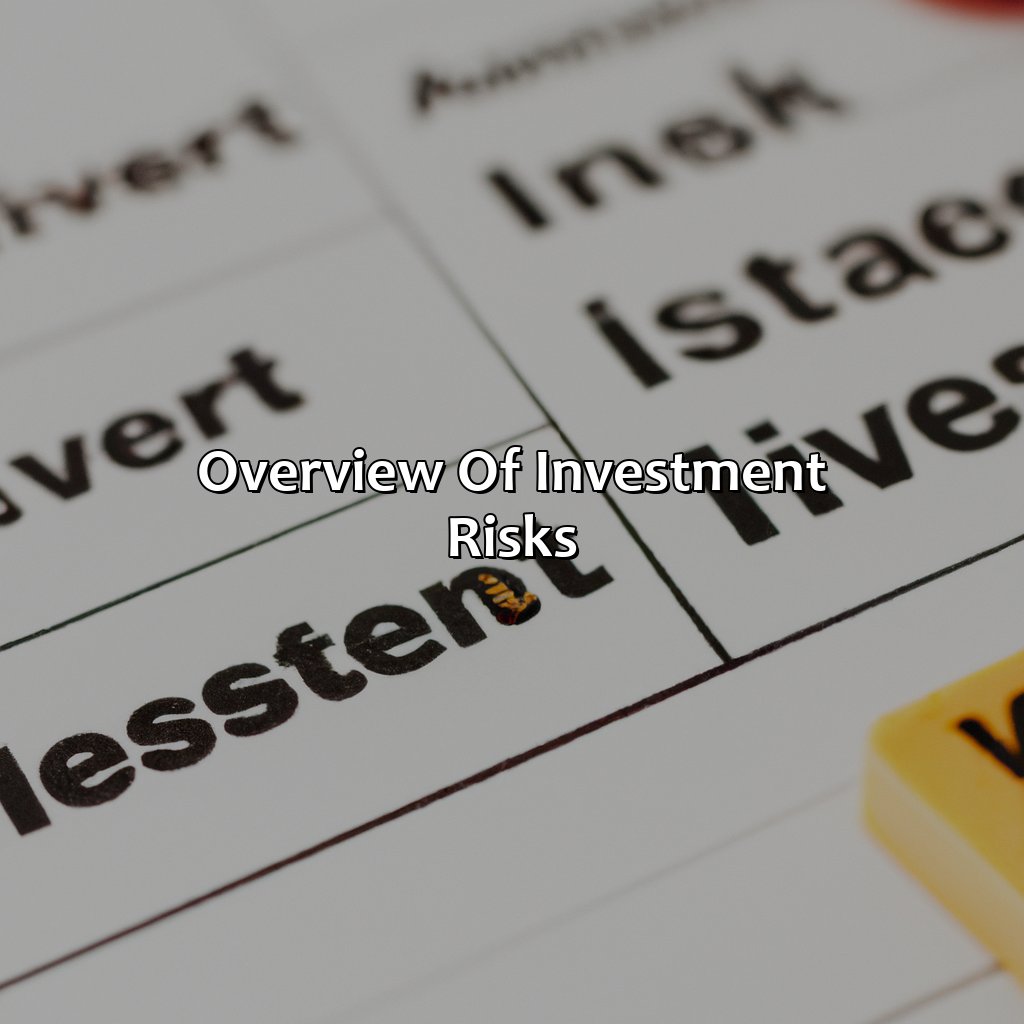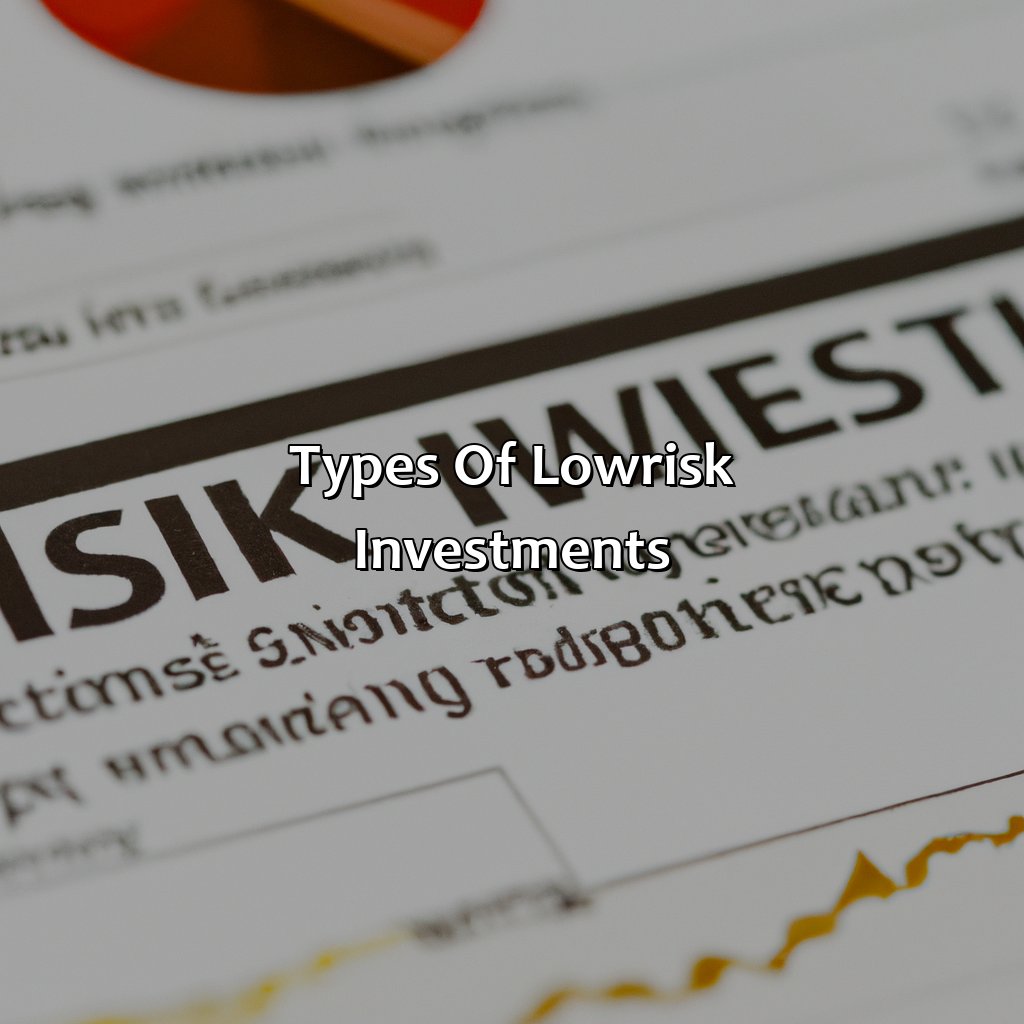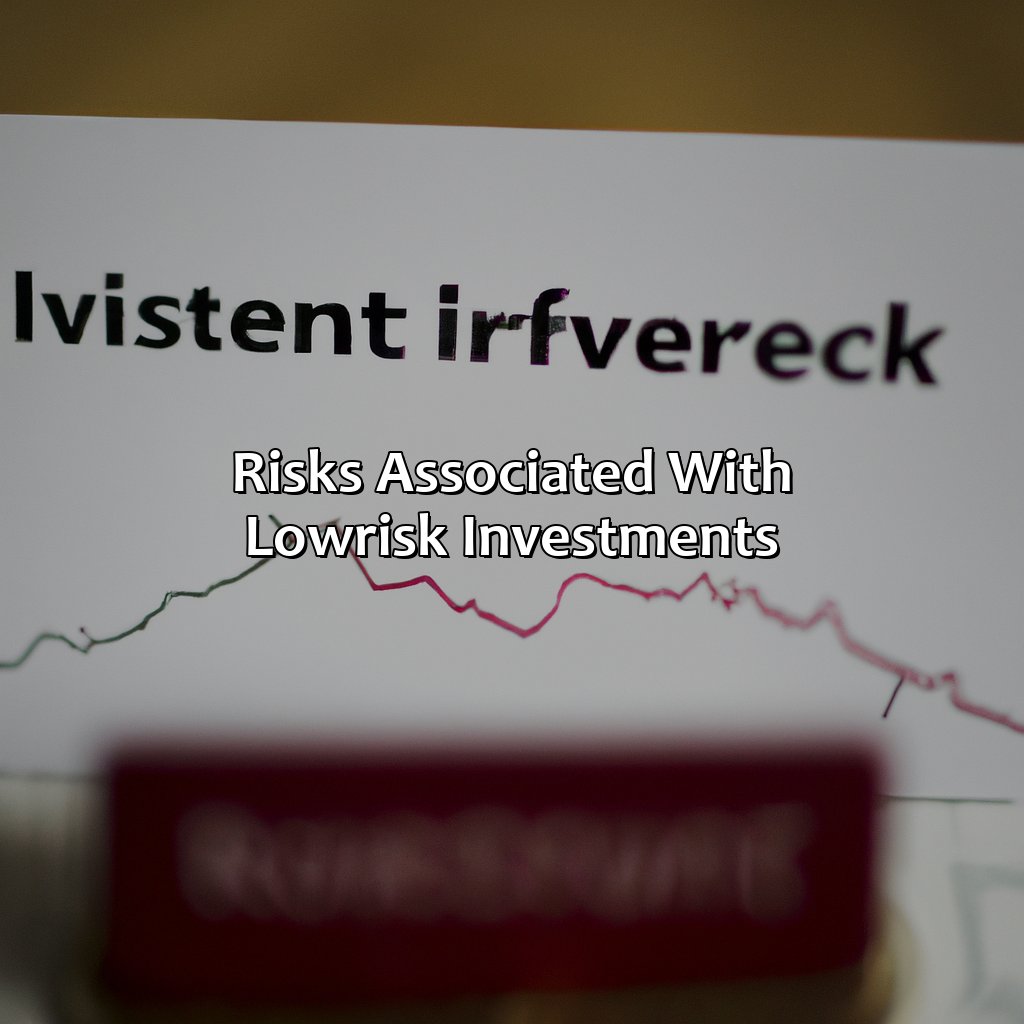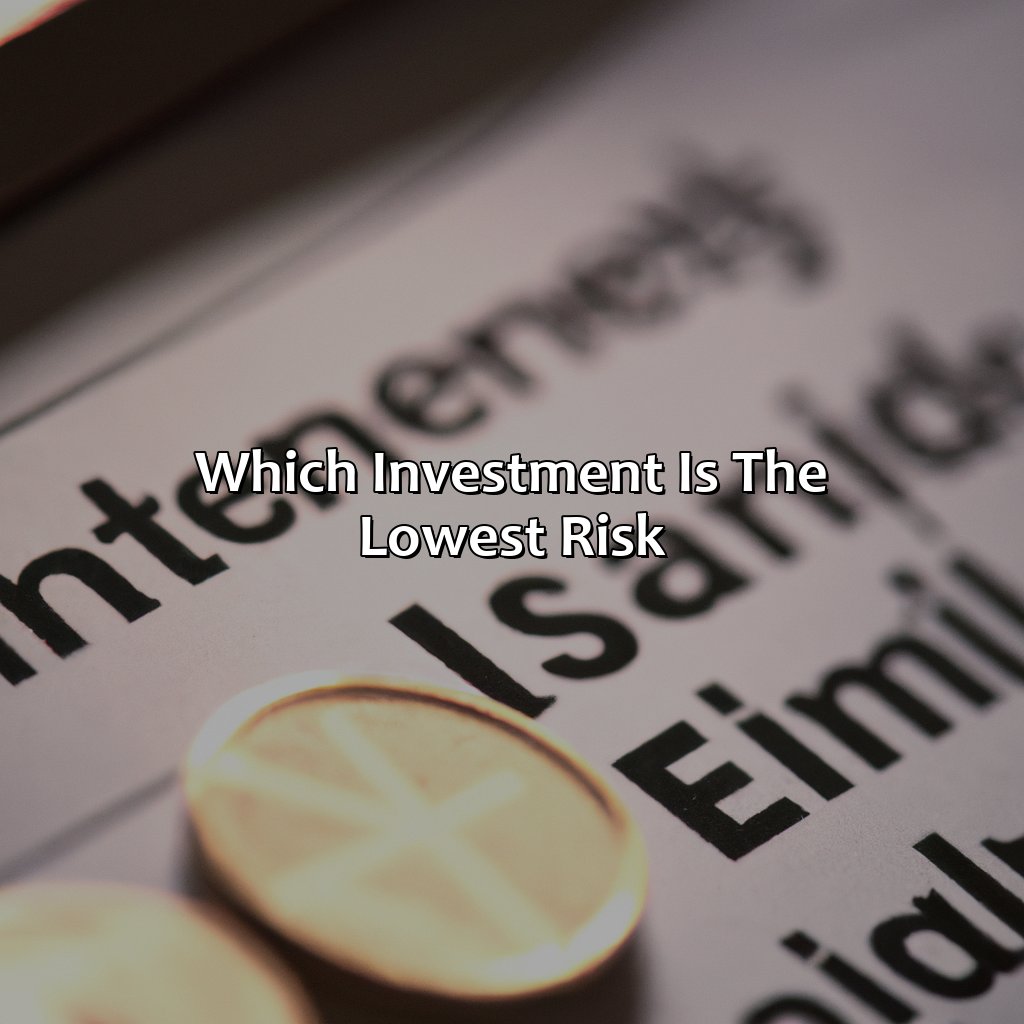Which Investment Is The Lowest Risk?
Key Takeaway:
- Low-risk investments include savings accounts, certificates of deposit (CDs), and money market funds. These investments offer safety and security due to lower volatility and lower risk of losing capital.
- However, low-risk investments are still subject to risks, such as inflation risk and interest rate risk. Inflation risk refers to the possibility of rising prices eroding the purchasing power of investments, while interest rate risk refers to the potential for interest rate changes to affect the value or income of investments.
- Factors to consider when choosing low-risk investments include investment goals, time horizon, diversification, and liquidity needs. It is important to assess the potential risks and returns of an investment and how it fits into an overall investment strategy before making a decision.
Struggling to decide where to invest your hard-earned money? You don’t have to take on unnecessary risks just to make a return. Discover which investments are the lowest risk with this article.
Overview of Investment Risks
Investment Risk Analysis for Better Investment Decisions
In the world of investments, choosing the right type of investment that aligns with your goals and risk appetite is essential. Understanding the risks associated with investments is equally important. The Overview of Investment Risks aims to provide detailed insights into various risks involved.
Different types of investments have varying degrees of risks, such as:
- Market risk occurs due to fluctuations in market value and can lead to losses.
- Inflation risk refers to the loss of value due to rising prices.
- Credit risk is associated with default of debt.
- Interest rate risk is the risk of losing value due to changes in interest rates.
Overall, the goal is to strike a balance between risk and return that aligns with your investment objectives. In summary, an investment with lower risk usually has lower returns, and vice versa.
Did you know that a study by Bankrate.com found that nearly 1 in 5 Americans had no retirement savings? It is crucial to start investing early and make informed decisions to secure your financial future.

Image credits: retiregenz.com by Harry Woodhock
Types of Low-Risk Investments
Investing safely?
Look into different types of investments! Savings accounts, Certificates of Deposit, and Money Market Funds can provide secure investing. Discover the advantages!

Image credits: retiregenz.com by Joel Woodhock
Savings Accounts
A commonly utilized investment tool, where an individual may put money into a financial institution which bears interest on the deposited amount is known as Interest Bearing Accounts. It’s categorized as short-term investments that are deemed low-risk options due to their negligible exposure to market volatility. The gains of such investments are much lower than than of other types but they offer minimal risk, thus being an ideal option for those who prioritize stability over profit margins.
Interest-bearing savings accounts date back to ancient Rome when merchants would deposit funds with local banks and earn interest from their endeavors. Since then, these types of accounts have exponentially expanded in usage and popularity within the modern economy.
Investing in CDs is like making a bet on a turtle race, slow and steady wins the race.
Certificates of Deposit (CDs)
Certificates of Deposit (CDs) are a type of investment that entails depositing funds in a financial institution for a set period of time. This investment is characterized by safety, low risk, and the assurance that your initial capital will not be lost.
- Interest rates on CDs are typically higher than those on savings accounts.
- The returns on CDs are constant and preset at the time of purchase.
- CDs come with a variety of terms ranging from 3 months to 10 years or more.
- Early withdrawals from CDs incur early withdrawal penalties.
- Certificates of Deposit can be bought through banks or credit unions.
Furthermore, it is worth noting that some banks offer specialized types of CDs such as:
- Jumbo CDs require a higher minimum deposit than regular CDs.
- Callable CDs allow the bank to redeem your CD before maturity if interest rates drop.
- Variable-rate CDs have interest rates which change over time based on market conditions.
A personal anecdote shared by an acquaintance whose CD matured after five years earning a fixed rate of 2.5 percent annually proves the lucrative nature of this type of investment. The accrued interest was substantial enough to pay off their student loan without jeopardizing their retirement savings. All things considered; Certificates of Deposits’ lower risk factor makes them suitable for individuals seeking guaranteed returns without risking their invested capital. A safe bet for those who want to dip their toes in investing without risking their entire piggy bank.
Money Market Funds
Investors looking for low-risk options may consider exploring investments such as short-term debt securities that are known as Semantic NLP variation of Money Market Funds.
These funds invest in high-quality and low-risk securities, making them a safer choice compared to other investments. Money market funds offer liquidity, stability, and preservation of principal investment. They provide a vehicle for investors who have cash to deploy but do not want the risk associated with investing in individual company stocks or bonds.
Money market funds provide an opportunity to earn a higher yield on idle cash balances while still ensuring safety and quick access to funds when needed.
Unique details about Semantic NLP variation of Money Market Funds include flexible maturity dates that help investors tailor their investments based on their financial needs and specific circumstances. These funds also have attractive interest rates, particularly during times of economic uncertainty.
Investors can explore various low-risk investment options to build a diversified portfolio, such as certificates of deposits (CDs), Treasury bills, and savings accounts. CDs offer fixed returns at an agreed-upon maturity date, while Treasury bills issued by the U.S government offer minimal risk and competitive yields.
You might be safer investing in a haunted house than a low-risk investment, at least the ghosts won’t disappear with your money.
Risks Associated with Low-Risk Investments
Want to learn about low-risk investments? We can help! Our article, “Which Investment is the Lowest Risk?”” breaks it down into two sections:
- Inflation Risk
- Interest Rate Risk
Mitigating these risks is key!

Image credits: retiregenz.com by Joel Jones
Inflation Risk
Low-Risk Investment’s Inherent Threat from Rising Prices
The potential loss of buying power due to price increases is one of the challenges that low-risk investments face. This threat is appropriately named ‘Purchasing Power Risk,’ and it occurs due to inflation-driven decreases in the value of a currency. It means that even with safe investments, such as savings accounts or money market instruments, you could still lose money when factoring in the impact of rising prices.
This risk can prove wholly detrimental to passive investments, especially those offering a fixed interest rate without adjusting for inflation. The nominal returns may seem attractive at first glance, but they decrease in relevance as the years pass by due to rising prices. One way to counteract this issue is by investing in assets that have historically outpaced inflation, such as stocks or real estate.
Inflation risk poses an additional danger when individual investors avoid augmenting their portfolio with diverse assets. Suppose all your assets solely comprise low-risk bonds unable to adapt to shifts in inflation rates. In that case, your financial strategy lacks protection against a substantial reduction in buying power over time.
To protect against inflation risk, diversified portfolios should consider stocks and alternative investment options such as commodities or real estate. By including these diverse assets suitable for risk tolerance levels, individuals can develop strategies designed to mitigate risks and grow their wealth over time. Act now before inflation silently chips away at your investment capital!
Low risk, low reward? More like low risk, low interest – am I right?
Interest Rate Risk
Investments are susceptible to interest rate changes, which can have a significant impact on returns. Fluctuations in interest rates can affect fixed-income securities, meaning that investors face interest rate risk. When interest rates rise, the value of a bond or similar security drops, and vice versa.
Furthermore, a low-risk investment may not necessarily be free from interest rate risk. For instance, certificates of deposit or other fixed-income securities offer predictable returns at low risks, but this capacity for predictability means that investors cannot take advantage of favorable changes in market conditions without losing out on expected returns.
One way to mitigate these risks is to diversify through holding a mixture of investments spread across various industries and currencies. Adding commodities such as gold has historically been seen as a buffer against inflationary pressures.
Interestingly, the concept of efficient investment strategies became apparent after John Maynard Keynes lost almost everything he owned following Britain’s departure from the gold standard in 1931. Overall, investors should be aware that there is no such thing as risk-free investing – even the lowest-risk options carry some level of uncertainty.
When it comes to low-risk investments, remember to consider more than just the risk factor; like how much you’ll have left for avocado toast after investing.
Factors to Consider When Choosing Low-Risk Investments
Choosing low-risk investments is a crucial decision in investment planning to avoid financial loss. The following are vital factors to consider before investing your money in any low-risk investment:
- Investment Objectives: Identify your investment goals, risk tolerance, and financial position before determining the investment type that best suits you.
- Liquidity: Ensure you choose a low-risk investment that is easy to convert into cash when needed or has a convenient liquidation process.
- Investment Horizon: Consider the length of time you are willing to invest before your investment matures or generates profits.
- Creditworthiness: Examine the creditworthiness and financial stability of the issuers or borrowers of the investment options.
- Historical Performance: Analyze the historical performance and current market trends of the investment option.
It is essential to note that investment risks and returns are inversely proportional and that past performance does not guarantee future returns.
A unique factor to consider is your personal bias towards risk, which could affect your investment decisions. It is crucial to address and manage biases to make rational investment decisions.
According to Forbes, low-risk investments such as government bonds, money market funds, and certificates of deposit had minimal disruption during the Covid-19 pandemic and may provide stability during economic uncertainties.

Image credits: retiregenz.com by James Arnold
Five Facts About Low-Risk Investments:
- ✅ Low-risk investments are generally those that provide a stable return with minimal fluctuations in value. (Source: The Balance)
- ✅ Examples of low-risk investments include government bonds, certificates of deposit, and high-yield savings accounts. (Source: NerdWallet)
- ✅ Low-risk investments typically offer lower potential returns compared to high-risk investments like stocks and real estate. (Source: Investopedia)
- ✅ Low-risk investments are often favored by investors who value stability and preservation of capital over growth. (Source: Forbes)
- ✅ It’s important to note that even low-risk investments carry some degree of risk, and investors should carefully consider their financial goals and risk tolerance before investing. (Source: The Motley Fool)
FAQs about Which Investment Is The Lowest Risk?
What is the lowest risk investment?
The lowest risk investment is typically a savings account or a certificate of deposit (CD) offered by a federally-insured bank or credit union. These types of investments are insured up to $250,000 by the Federal Deposit Insurance Corporation (FDIC), making them very safe options.
What are the characteristics of a low-risk investment?
A low-risk investment typically has a low rate of return and a high level of safety. These investments are often characterized by their stability and consistency, as they are designed to protect your capital and provide a steady stream of income over time.
What are some examples of low-risk investments?
Some common examples of low-risk investments include savings accounts, CDs, money market accounts, short-term bonds, and Treasury bills. These investments are considered low-risk because they have a low level of volatility and are backed by the full faith and credit of the U.S. government.
How does a low-risk investment differ from a high-risk investment?
A low-risk investment typically offers a lower rate of return than a high-risk investment, but it also comes with a higher level of safety. High-risk investments, such as stocks or cryptocurrencies, offer the potential for high returns but also come with a higher level of volatility and the potential for significant losses.
What are the benefits of investing in low-risk investments?
The main benefit of investing in low-risk investments is the peace of mind that comes with knowing your money is safe. These investments offer a stable, predictable return and are ideal for individuals who are looking to preserve their capital over the long term.
How do I choose the right low-risk investment for me?
Choosing the right low-risk investment depends on your individual goals, risk tolerance, and time horizon. Consider factors such as the interest rate, fees, and maturity date when evaluating different options. It may also be helpful to consult with a financial advisor to determine which investment is best suited to your needs.
